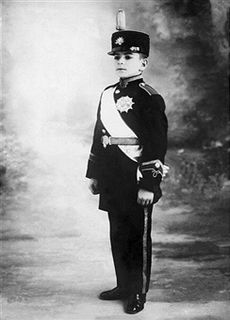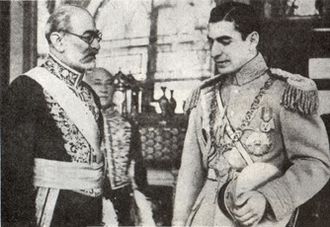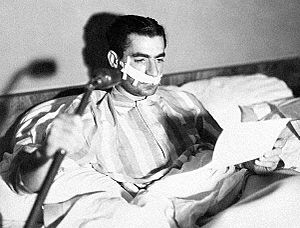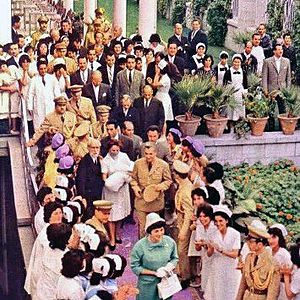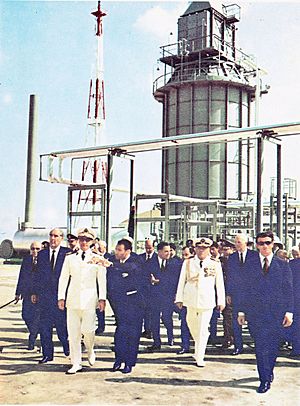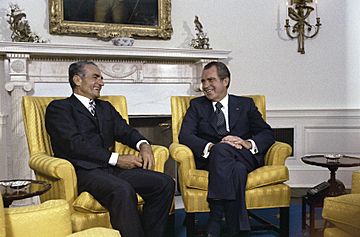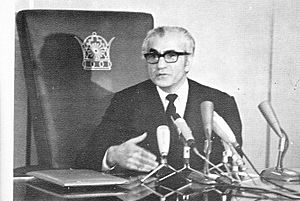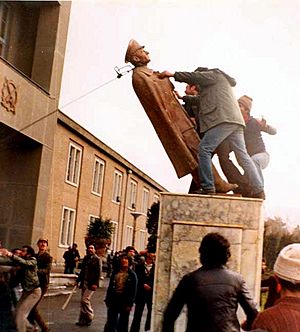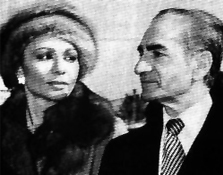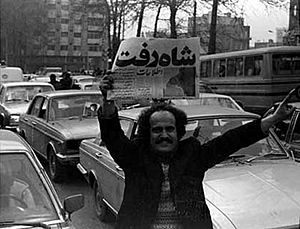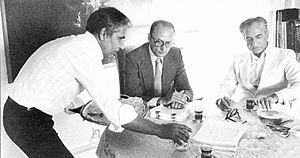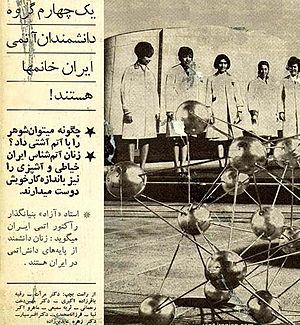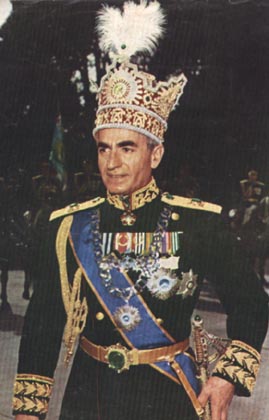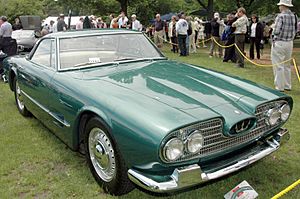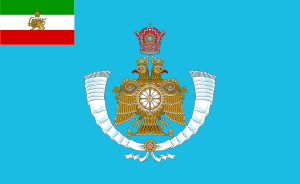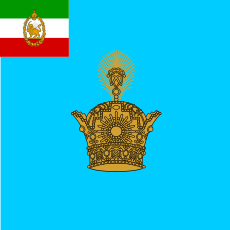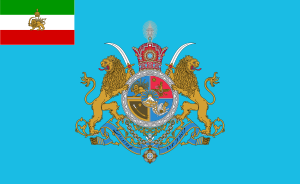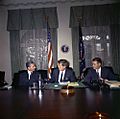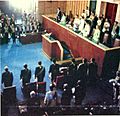Mohammad Reza Pahlavi facts for kids
Quick facts for kids Mohammad Reza Shah Pahlavi |
|||||
|---|---|---|---|---|---|
| King of Kings Light of the Aryans Commander-in-Chief of the Iranian Armed Forces |
|||||
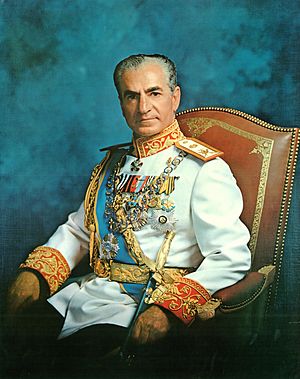
Shah in 1973
|
|||||
| Shah of Iran | |||||
| Reign | 16 September 1941 – 11 February 1979 | ||||
| Coronation | 26 October 1967 | ||||
|
See list
Mohammad-Ali Foroughi
Ali Soheili Ahmad Qavam Mohammad Sa'ed Morteza-Qoli Bayat Ebrahim Hakimi Mohsen Sadr Mohammad-Reza Hekmat Abdolhossein Hazhir Ali Razmara Hossein Ala' Mohammad Mosaddegh Fazlollah Zahedi Manouchehr Eghbal Jafar Sharif-Emami Ali Amini Asadollah Alam Hassan-Ali Mansur Amir-Abbas Hoveyda Jamshid Amouzegar Gholam-Reza Azhari Shapour Bakhtiar |
|||||
| Predecessor | Reza Shah | ||||
| Successor | Monarchy abolished Ruhollah Khomeini as Supreme Leader |
||||
| Born | 26 October 1919 Tehran, Sublime State of Persia |
||||
| Died | 27 July 1980 (aged 60) Cairo, Egypt |
||||
| Burial | 29 July 1980 Al-Rifa'i Mosque, Cairo, Egypt |
||||
| Spouse |
|
||||
| Issue |
|
||||
|
|||||
| Alma mater |
|
||||
| House | Pahlavi | ||||
| Father | Reza Shah | ||||
| Mother | Tadj ol-Molouk | ||||
| Religion | Twelver Shi’ism | ||||
| Signature |  |
||||
| Military career | |||||
| Allegiance | Iran | ||||
| Service/ |
Imperial Iranian Army | ||||
| Years of service | 1936–1941 | ||||
| Rank | Captain | ||||
| Commands held | Army's Inspection Department | ||||
Mohammad Reza Pahlavi (born October 26, 1919 – died July 27, 1980) was the last Shah (King) of Iran. He ruled from September 16, 1941, until he was overthrown by the Iranian Revolution on February 11, 1979. People often called him "the Shah."
Mohammad Reza Shah took important titles like Shahanshah ("King of Kings") and Aryamehr ("Light of the Aryans"). He was the second and final ruler of the Pahlavi dynasty. He dreamed of a "Great Civilization" for Iran. This led to fast changes in industry and the military, along with economic and social improvements.
Mohammad Reza became king during World War II. His father, Reza Shah, had to step down after the Anglo-Soviet invasion of Iran. During Mohammad Reza's rule, Iran's oil industry, which was owned by the British, was briefly taken over by the Iranian government. This happened under Prime Minister Mohammad Mosaddegh. Later, a military coup, supported by the UK and the US, removed Mosaddegh. The Shah returned to power, and foreign oil companies came back under a new agreement. The Shah then became a powerful figure in OPEC, helping to raise oil prices. This had a big impact on Western economies.
Mohammad Reza started the White Revolution. These were major changes meant to make Iran a strong, modern country. He took control of important industries and shared land with farmers. His government also promoted Iranian national symbols like Cyrus the Great. The Shah invested a lot in roads, dams, and factories. He also gave money and land to farmers and helped factory workers share in profits. Education programs were set up, and many natural resources were taken over by the government. By the 1970s, Iran's economy was growing very fast. Its military also became one of the strongest in the world.
By 1978, growing protests led to a revolution. Events like the Jaleh Square massacre and the Cinema Rex fire made his position difficult. He left Iran on January 17, 1979. The Iranian monarchy was then ended, and Iran became an Islamic Republic. The Shah died in Egypt, where he had found safety.
Contents
Early Life and Education
Mohammad Reza was born in Tehran on October 26, 1919. His father was Reza Khan, who later became Reza Shah Pahlavi, the first king of the Pahlavi dynasty. His mother was Tadj ol-Molouk. Mohammad Reza was the oldest son and had a twin sister named Ashraf.
His father became Shah in 1925. Before that, Mohammad Reza and his siblings were not born into royalty. Mohammad Reza was named Crown Prince when his father was crowned king in 1926.
Growing Up in the Royal Family
Mohammad Reza described his father as a very strong and sometimes scary man. His father wanted him to be tough and did not show him much affection when he was young. This made Mohammad Reza a bit shy and unsure of himself.
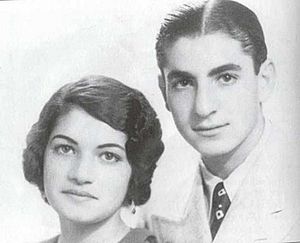
His mother, Tadj ol-Molouk, was very supportive. She believed that Mohammad Reza was chosen for great things. He was very close to his twin sister Ashraf. She said that her life was always tied to her brother.
After becoming Crown Prince, Mohammad Reza was trained by military officers. Everyone, even his family, had to call him "Your Highness." This upbringing made him a mix of gentle and strong, shy and confident.
School Days

When Mohammad Reza was 11, his father sent him to Institut Le Rosey, a boarding school in Switzerland. He learned French there and loved European culture. He played football but was described as "timid."
He was the first Iranian prince to study abroad. He returned to Iran in 1936 and joined a military academy in Tehran. He graduated as a Second Lieutenant in 1938 and was quickly promoted to captain. He spent three years inspecting military sites across the country.
Mohammad Reza spoke English, French, and German very well, in addition to his native Persian.
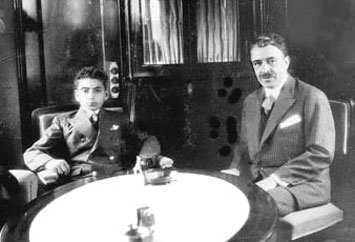
Becoming King
First Marriage
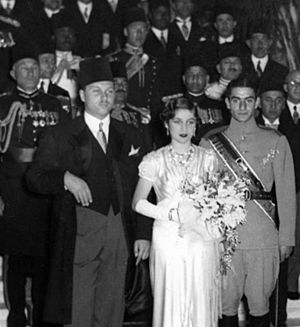
In 1939, Mohammad Reza married Princess Fawzia of Egypt. She was the sister of King Farouk I of Egypt. This marriage was meant to strengthen ties between Iran and Egypt.
They had one daughter, Princess Shahnaz Pahlavi. Their marriage was not happy, and they divorced in 1948.
His Father's Abdication
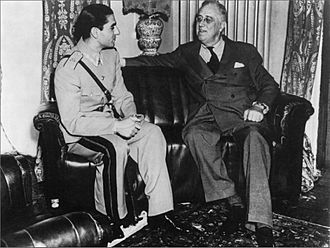
In 1941, during World War II, British and Soviet forces invaded Iran. They were worried about German influence in Iran. This invasion forced Mohammad Reza's father, Reza Shah, to step down from the throne.
Mohammad Reza was shocked to see the Iranian military collapse so quickly. This event made him determined to build a strong military so Iran would never be defeated again.
Taking the Throne
On September 16, 1941, Mohammad Reza became the new Shah of Iran. He took an oath in parliament and was welcomed by the people. The British and Soviets accepted him as king because he seemed like a stable choice.
Iran then became an important route for supplies from Britain and America to the Soviet Union during the war. This was known as the Persian Corridor.
Mohammad Reza issued a general pardon for political prisoners. He also ended his father's policy of forcing women to remove their veils. In his early years as Shah, he lacked confidence.
Oil and the 1953 Coup
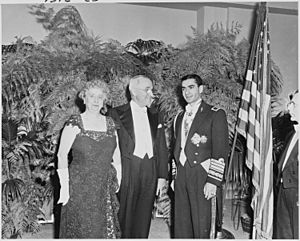
In the early 1950s, Iran faced a big political challenge. Prime Minister Mohammad Mosaddegh wanted to take control of Iran's oil industry. This industry was owned by a British company. The Iranian parliament voted to nationalize the oil, meaning it would belong to Iran.
The United States and Britain were worried about this. They feared that communists might gain power in Iran. In 1953, the American CIA and British intelligence secretly worked together. They planned to remove Mosaddegh from power. This plan was called Operation Ajax.
The Shah signed orders to dismiss Mosaddegh and replace him with General Fazlollah Zahedi. The first attempt to carry out the coup failed, and the Shah had to flee to Italy. However, a second attempt succeeded. Mosaddegh was arrested, and General Zahedi became the new prime minister.
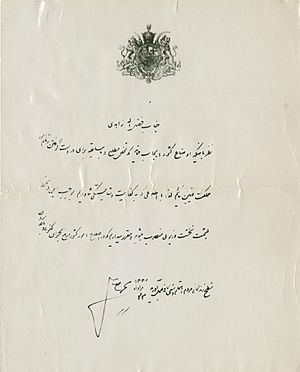
The Shah returned to power. This event made many Iranians feel that Western countries interfered too much in their politics.
Second Marriage
In 1949, there was an attempt to assassinate the Shah at Tehran University. He was shot five times but survived. The attacker was killed.
The Shah's second wife was Soraya Esfandiary-Bakhtiary. They married in 1951. She was half-German and half-Iranian. Their marriage did not last because they could not have children, and the Shah needed an heir to the throne. They divorced in 1958.
Big Changes in Iran
The White Revolution
In 1963, Mohammad Reza started the White Revolution. This was a series of big changes for Iran. He wanted to modernize the country and make it a global power.
Key parts of the White Revolution included:
- Land Reform: Large farms were divided and given to over four million small farmers.
- Women's Rights: Women gained the right to vote.
- Profit Sharing: Factory workers received a share of company profits.
- Education: Many new schools were built. Literacy programs, like the "Army of Knowledge," sent soldiers to teach in villages. By 1977, over 80% of Iranians could read and write.
- Infrastructure: Major investments were made in roads, dams, and factories. New industries like steel and petrochemicals grew.
These changes led to fast economic growth. Iran's income grew greatly, and people's living standards improved.
Imperial Coronation and Celebrations
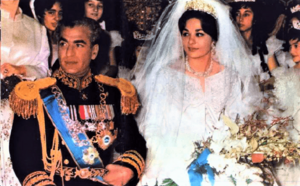
In 1959, Mohammad Reza married his third wife, Farah Diba. She became the Shahbanu (Empress) in 1967. They had four children:
- Crown Prince Reza Pahlavi
- Princess Farahnaz Pahlavi
- Prince Ali Reza Pahlavi
- Princess Leila Pahlavi
On October 26, 1967, Mohammad Reza had a grand coronation ceremony in Tehran. He took the title Shāhanshāh ("Emperor" or "King of Kings"). He said he waited to take this title until he felt Iran was strong enough.
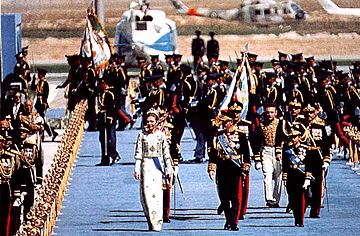
In October 1971, the Shah celebrated 2,500 years of continuous Persian monarchy. This event honored the founding of the Achaemenid Empire by Cyrus the Great. He even changed the Iranian calendar to start from Cyrus the Great's coronation.
The celebration at Persepolis was very grand. It showed that Iran respected its ancient past but was also a modern nation.
Oil Prices and the Economy
Prior to 1973, Iran pushed for higher oil prices through OPEC. After the Yom Kippur War in 1973, Arab countries stopped selling oil to Western nations. The Shah used this chance to increase Iran's oil prices.
This led to a huge increase in Iran's oil income. Iran's economy grew very fast, with a 33% growth rate in 1973 and 40% the next year. The Shah used this money to invest in education, healthcare, and the military.
Iran's economy grew faster than many developed countries. By the mid-1970s, Iran had paid off its national debt and became a creditor nation. Manufacturing of cars, appliances, and other goods increased a lot. This led to more people moving to cities.
Foreign Relations
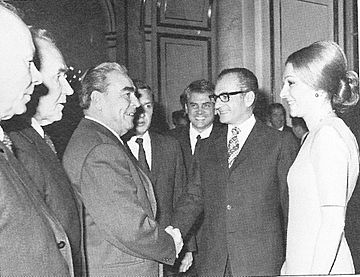
The Shah wanted Iran to be a strong and respected nation. He had good relationships with Western countries, especially the United States. He also worked with countries like France and Germany.
He saw Iran as the main power in the Persian Gulf region. He spent a lot of money on the military to show Iran's strength. He supported countries like Oman against rebellions.
Relations with Iraq were often difficult. The Shah ended a treaty about the Shatt al-Arab river border, which caused tension. He also supported Kurdish rebels in Iraq for a time. In 1975, Iran and Iraq signed a new agreement, and the Shah stopped supporting the Kurds.
The Shah also had close ties with leaders like King Hussein of Jordan and President Anwar Sadat of Egypt.
The Revolution Begins
Growing Unrest
In the later years of his rule, the Shah's government became more controlling. In 1975, he ended the two-party system and created a single political party called Rastakhiz. He said that anyone who did not join the party was a "traitor."
This made many Iranians unhappy. People were also upset about inflation, poverty, and corruption. The Shah's grand celebrations seemed out of touch with the struggles of ordinary people.

Protests against the Shah began in October 1977. On January 7, 1978, a newspaper article attacked Ruhollah Khomeini, a religious leader living in exile. This caused more protests, especially in the holy city of Qom.
The Shah's Health
Mohammad Reza was diagnosed with a type of cancer in 1974. This was kept a secret, even from the United States. As his health worsened in 1978, he stopped appearing in public. This led to rumors and made people question his leadership.
His illness made him indecisive and passive. This made it harder for his government to deal with the growing protests.
Black Friday
On September 8, 1978, a major event known as "Black Friday" occurred. Thousands of people gathered in Tehran's Jaleh Square for a religious protest. Soldiers opened fire on the crowd, killing and injuring many people. This event made the protest movement even stronger and harder to stop.
The Monarchy Falls Apart
In October 1978, the Shah offered a general pardon to Iranians living abroad, including Ayatollah Khomeini. But it was too late. Strikes paralyzed the country, and millions of people protested against the Shah.
Oil workers went on strike, stopping Iran's main source of income. The military's loyalty also began to weaken. On November 5, 1978, the Shah went on TV and promised major reforms. He freed political prisoners and arrested former officials, but these actions did not calm the situation.
Exile and Death
On January 16, 1979, Mohammad Reza left Iran. He hoped this would calm the situation. As he boarded the plane, many of his guards cried. Soon after, people destroyed statues of the Pahlavi family across Iran.
The new Prime Minister, Shapour Bakhtiar, dissolved the secret police (SAVAK) and allowed Ayatollah Khomeini to return. Khomeini, however, rejected Bakhtiar's government. By February 11, the monarchy was officially ended.
During his exile, Mohammad Reza traveled to several countries. He first went to Aswan, Egypt, where President Anwar Sadat welcomed him. He then lived in Marrakesh, Morocco, and later in the Bahamas and Cuernavaca, Mexico.
He needed medical treatment for his cancer. He eventually went to the United States for surgery in October 1979. His long stay in the U.S. was very unpopular in Iran. The Iranian government demanded his return.
After his treatment in the U.S., he left for Contadora Island in Panama. He was not treated well there and felt like a prisoner. He then returned to Egypt in March 1980 for more medical care.
Mohammad Reza's health continued to worsen. He died on July 27, 1980, at the age of 60 in Cairo, Egypt. President Sadat gave him a state funeral. He is buried in the Al Rifa'i Mosque in Cairo.
Why the Revolution Happened
Many reasons led to the Shah's overthrow:
- Dictatorial Rule: He was seen as a dictator, especially after creating a one-party state.
- Foreign Influence: Many Iranians disliked that the U.S. had helped him return to power in 1953.
- Oppression and Corruption: There were reports of his government being harsh and corrupt.
- Economic Problems: Despite growth, there were economic issues like inflation and shortages.
- Extravagance: His lavish spending, like the 1971 Persepolis celebration, angered many poor Iranians.
- Cultural Changes: His efforts to modernize Iran and emphasize pre-Islamic history upset religious leaders and traditionalists.
- Illness: His secret illness made him unable to lead effectively during the crisis.
Some of his achievements, like expanded education, also had unexpected results. Many educated young people could not find jobs, and they joined the revolution.
Achievements and Legacy
The Shah's "White Revolution" brought many changes to Iran. He helped small farmers and gave women the right to vote. He also allowed workers to share in factory profits.
Education improved greatly. The number of universities and students increased a lot. Literacy programs helped many people learn to read and write.
Iran became a strong power in the Middle East. The Shah invested in new technologies like steel, telecommunications, and power plants. The Aryamehr University of Technology was founded.
Iran's economy grew very fast during his rule. From 1963 to 1976, Iran's industrial growth was over 20% per year. People's income increased significantly. Iran's middle class grew larger than in many other developing countries.
After his overthrow, Mohammad Reza wrote a book called Answer to History. In it, he shared his views on his rule and the revolution.
Women's Rights
Under the Shah, women gained more rights. They could choose any profession, and some became ministers or judges. This included Farrokhroo Parsa, the first female Iranian minister, and Shirin Ebadi, a judge. Mehrangiz Dowlatshahi became the first female cabinet member and ambassador. These changes were not popular with traditional religious groups.
Wealth
Mohammad Reza inherited a lot of wealth from his father. He was known as the richest person in Iran. He owned vast amounts of land and many estates.
To address concerns about his wealth, he created the Pahlavi Foundation in 1958. This was a charity that held his assets. However, the foundation was sometimes accused of corruption.
The Shah also loved cars. He had a collection of 140 classic and sports cars. The first Maserati 5000 GT was even built for him and named "the Shah of Persia."
Titles and Symbols
Mohammad Reza held many important titles and received honors from around the world. After his coronation in 1967, he used the title His Imperial Majesty. He was also called Aryamehr ('Light of the Aryans').
Imperial Symbols
The Pahlavi royal family used special symbols. The imperial crown was on all official documents and military badges. It was also the main part of the Shah's personal flag.
| Imperial standard of Crown Prince Mohammad Reza (1926–1941) |
Imperial standard of Mohammad Reza Shah (1941–1971) |
Imperial standard of Mohammad Reza Shah (1971–1980) |
Images for kids
-
Pahlavi (center), pictured between Joseph Stalin and Vyacheslav Molotov at the Tehran Conference.
-
Mohammad Reza, U.S. President John F. Kennedy, and Secretary of Defense Robert McNamara in the White House Cabinet Room, 1962
-
The Shah and his wife visited Espoo, Finland in June 1970. President Urho Kekkonen next to the Shah.
-
The Shah with his wife Farah meets Indira Gandhi in India, 1970
-
The Shah meeting Algerian President Houari Boumediène and Iraqi Vice President Saddam Hussein in Algiers in order to sign the 1975 Algiers Agreement
-
Mohammad Reza and Gerald Ford on the South Lawn, 1975
-
Mohammad Reza shakes hands with members of OPEC in a landmark session in Tehran, 1970
-
Lunar astronaut Neil Armstrong meeting the Shah of Iran during visit of Apollo 11 astronauts to Tehran on 28–31 October 1969
-
Mohammad Reza Shah toasting with U.S. President Jimmy Carter at the Niavaran Palace, 31 December 1977
-
Mohammad Reza during his Hajj pilgrimage in the 1970s
See also
 In Spanish: Mohammad Reza Pahleví para niños
In Spanish: Mohammad Reza Pahleví para niños
- Guadeloupe Conference
- History of Iran
- Human rights in the Imperial State of Iran
- Mediterranean and Middle East theatre of World War II
- Monarchism in Iran
- National Car Museum of Iran, showcases the cars of Mohammad Reza
- Nuclear program of Iran
- Trans-Iranian Railway
- White Revolution
- 1979 Iranian Revolution conspiracy theory


